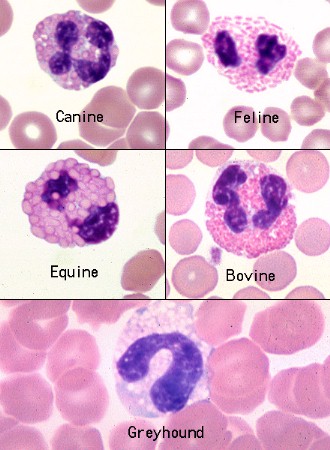 Eosinophil granules in most animals are orange but there are always exceptions.
The granules in eosinophils of iguanas and some birds are actually pale blue. In general, nuclei
of mature eosinophils are shorter and less segmented than neutrophil nuclei and the cytoplasm,
if visible, is pale blue. Marked species variation exists regarding the number, size, and
shape of eosinophil granules.
Eosinophil granules in most animals are orange but there are always exceptions.
The granules in eosinophils of iguanas and some birds are actually pale blue. In general, nuclei
of mature eosinophils are shorter and less segmented than neutrophil nuclei and the cytoplasm,
if visible, is pale blue. Marked species variation exists regarding the number, size, and
shape of eosinophil granules.
The most intraspecies variation is found in dog eosinophils. Marked variation in granule size, number and shape occurs within and between individuals of any breed. A specific and predictable morphologic variant of the eosinophil is seen in greyhounds and other sighthounds (eg, whippets, deerhounds). Eosinophils in these breeds lack visible granules and appear as cells with slightly segmented nuclei, gray cytoplasm, and vacuoles. They are sometimes mistaken for toxic neutrophils or monocytes. Eosinophils of the cat have small rod-shaped orange granules that fill the cytoplasm, while those of the horse have very large globular orange granules. Ruminant eosinophils have many small very round orange granules. |
Last updated on Sunday, February 11, 1996